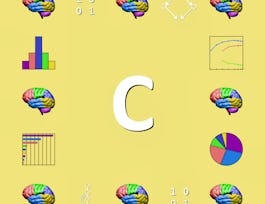This course introduces the necessary concepts and common techniques for analyzing data. The primary emphasis is on the process of data analysis, including data preparation, descriptive analytics, model training, and result interpretation. The process starts with removing distractions and anomalies, followed by discovering insights, formulating propositions, validating evidence, and finally building professional-grade solutions. Following the process properly, regularly, and transparently brings credibility and increases the impact of the results.



Recommended experience
What you'll learn
1. Apply appropriate techniques for generating insights from data.
2. Present actionable solutions with confidence to the business stakeholders.
Details to know

Add to your LinkedIn profile
32 assignments
See how employees at top companies are mastering in-demand skills


Earn a career certificate
Add this credential to your LinkedIn profile, resume, or CV
Share it on social media and in your performance review

There are 9 modules in this course
Welcome to Data Preparation and Analysis! Module 1 guides students through the art of crafting informative and visually appealing histograms, a fundamental aspect of data visualization. Students will learn techniques for measuring the location and scale of data, understanding the origins and impacts of noise and missing values in datasets. This module also introduces the CRISP-DM Process, a structured approach to data mining, along with Gartner's Analytics Ascendancy Model for advanced data analysis. Additionally, students will explore the distinction between raw data and processed information, a key concept for effective data interpretation and decision-making.
What's included
10 videos7 readings4 assignments1 discussion prompt1 ungraded lab
Module 2 delves into the intricacies of statistical analysis, beginning with a thorough understanding of the p-value concept and its significance as a Type I Error indicator. Students will learn to apply statistical tests in Python to identify significantly correlated features, exploring various correlation metrics tailored for categorical, mixed-type, and continuous features. This module emphasizes practical application, equipping students with the skills to calculate and interpret these metrics using Python, thereby enhancing their ability to conduct sophisticated data analysis and draw meaningful conclusions from complex datasets.
What's included
7 videos5 readings4 assignments1 ungraded lab
Module 3 offers a deep dive into the world of Association Rules, teaching students how to improvise these rules for identifying valuable feature combinations that generate specific label values. Learners will master setting appropriate thresholds for Support and Confidence and gain a comprehensive understanding of the Apriori Algorithm and the significance of Frequent Itemsets within it. This module covers the calculation of common metrics for Association Rules, familiarizing students with the relevant terminology. Additionally, learners will explore the practical application of Association Rules in Market Basket Analysis, including strategies for cross-selling, up-selling, and product bundling, equipping them with valuable skills for advanced data-driven decision making in business contexts.
What's included
7 videos5 readings3 assignments1 ungraded lab
In Module 4, students will learn how to describe and interpret profiles of clusters, gaining proficiency in deploying the K-Means and K-Modes clustering algorithms. They will explore the application of Recency, Frequency, and Monetary (RFM) Analysis to identify the most valuable customers in retail business settings. The module also covers the technique of Simple Random Sampling with the option of incorporating stratification variables, enhancing the precision of data analysis. Furthermore, it emphasizes the importance of objectively validating models using a testing partition, ensuring the reliability and effectiveness of the analytical models in real-world scenarios.
What's included
8 videos5 readings4 assignments1 ungraded lab
This module delves into feature importance analysis in machine learning, covering Shapley Values, feature selection methods, statistical evaluation, feature interaction, aliasing, and the Least Squares Algorithm. Students will be able to master these concepts to build robust and interpretable models.
What's included
8 videos5 readings4 assignments1 ungraded lab
In Module 6, students will master the art of feature selection in machine learning by exploring the Forward and Backward Selection Method, the All-Possible Subsets Method, and the concept of complete and quasi-complete separation. Students will also discover association rules for identifying separations, interpret model parameters and predicted probabilities, and delve into the concepts of maximum likelihood estimation, odds, and odds ratios.
What's included
6 videos5 readings4 assignments1 ungraded lab
Module 7 will equip students wth the ability to harness the power of tree-based models to uncover hidden patterns in your data. Students will be able to describe clusters effectively, intelligently set algorithm parameters, construct business rules from tree results, and utilize variance metrics, entropy values, and Gini indices for optimal tree construction.
What's included
7 videos5 readings4 assignments1 ungraded lab
Module 8 delves into the realm of evaluation metrics for machine learning models. Students will master the concepts of precision and recall curves, lift curves, and receiver operating characteristics (ROC) curves. Additionally, students will obtain the ability to discover methods for calculating probability thresholds using Kolmogorov-Smirnov statistics and F1 scores. They will be able to explore metrics like misclassification rate, area under the curve (AUC), and root mean squared error (RMSE), along with techniques for computing RMSE and detecting severely misfitted observations using model-specific residuals.
What's included
8 videos5 readings4 assignments1 ungraded lab
This module contains the summative course assessment that has been designed to evaluate your understanding of the course material and assess your ability to apply the knowledge you have acquired throughout the course. Be sure to review the course material thoroughly before taking the assessment.
What's included
1 assignment
Instructors


Offered by
Why people choose Coursera for their career




Recommended if you're interested in Data Science

Corporate Finance Institute

University of Pennsylvania

University of Colorado System

Coursera Project Network

Open new doors with Coursera Plus
Unlimited access to 10,000+ world-class courses, hands-on projects, and job-ready certificate programs - all included in your subscription
Advance your career with an online degree
Earn a degree from world-class universities - 100% online
Join over 3,400 global companies that choose Coursera for Business
Upskill your employees to excel in the digital economy


